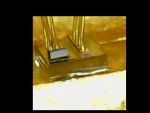Apparently not - as goes with so many things in asia. You'll often find even things like restaurant menu's printed on very expensive material containing blatant spelling and grammar mistakes that even a non-native speaker would easily spot.
But when it's in a technical document like this it also makes me wonder if they have taken any care to present the correct information at all. I presume this was translated from kantonese or mandarin into english by someone that, apparently, does not speak english all that well but at least made the effort.
The main problem is that it does -not- really say what could cause the damage. Hermetically sealed package is fine, but what is contained inside? Is it in dry air, a vacuum, argon, nitrogen, sulfur hexafluoride, or perhaps something totally different?
It's feasible that the chip could be damaged by oxygen from the air, but also that it's not. Things like water vapor or dust are also likely contaminants that could kill it.
I remember the transistors in metal can bodies. Those worked just fine if you opened the can, but circuits would go haywire due to -light- getting in and turning them on. The transistor chip itself was perfectly fine exposed to air, but became essentially a photo transistor that just turned on when lit, regardless of any base drive current










